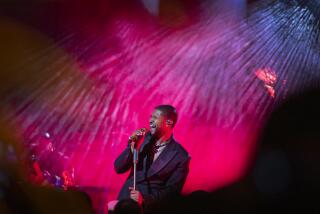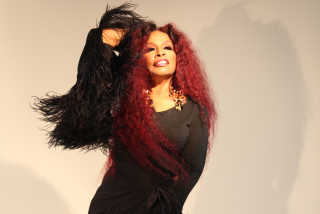Into the Arena, Again : When Pavarotti Comes to Town, It’s a Big Event for the Fans and at the Box Office
- Share via
When Luciano Pavarotti touches down Monday at the 18,000-seat Hollywood Bowl--with his entourage of managers, sound engineers and assorted musical assistants--the product will be yet another installment in the tenorissimo’s specialty: the arena show.
Other opera stars, as opposed to pop stars, are confined to smaller platforms. But everything about Pavarotti, that scale-tipping, cherub-faced vocal icon who clutches a big white handkerchief and clenches his eyes with fervor, is outsized. Including his appeal.
“All the world wants to hear him,” says Herbert Breslin, the P. T. Barnum of classical artists, Pavarotti’s manager and the man who dreamed up the idea of these arena shows.
“Why should we limit Pavarotti’s audiences to halls that fit just a fraction of those who want to hear him? If he can draw the masses with the magic of his voice, why should we keep them away? Many of these people are hearing opera for the first time. Who among the pundits and standard-bearers would want to discourage them?”
Breslin’s conditioned defense comes from a barrage of criticism. By capitalizing on Pavarotti’s charisma, some say he has sullied a classical art and vulgarized his client’s image. A case of media show biz beating out elite refinement.
The Italian singer first served notice of those qualities locally at Royce Hall in 1973. A decade of appearances at such customary forums led--some say, inevitably--to the arena. This Hollywood Bowl event, a benefit for the Los Angeles Philharmonic’s Pension Fund, marks his return to the amphitheater after a five-year absence.
Breslin will not disclose Pavarotti’s fee (reported to be around $100,000) saying only that “money doesn’t enter the picture” as far as motivation to sing these concerts goes.
“Applause is my oxygen,” Pavarotti confessed in his early autobiography. Just before his last Bowl concert, he declared that he was “very proud to bring music to the people in the arenas” and that the public “loves these big places.”
Breslin also said that the sponsoring organization--in this case, the L.A. Philharmonic--”comes out gaining” because of ticket prices that soar to $1,000 each (including champagne and caviar dinner).
Tibor Rudas, the impresario who for the last 10 years has devoted himself to these extravaganzas, says that “the house was sold four hours after the only ad appeared and we had to shut down the box office,” a slight exaggeration over the Philharmonic marketing department’s report that it took “a few days.”
Explaining the sellout, Rudas says: “Audiences want to hear him, only him. If it’s a koala bear you wish to buy then some other type does not satisfy the desire.”
A few ads have even blossomed in newspaper classified sections offering tickets, placing Pavarotti in the unusual company of such pop acts as the Scorpions and Sting.
Rudas also praises a “multimillion-dollar acoustic system that brings state-of-the-art technology” to each venue and hasn’t been heard here before.
“Using a laser beam computer, it spreads the sound without actually enlarging the voice. We need two 40-foot trailers to carry it around, and eight men, plus local hires, take 24 hours to set it up.”
Most of the mass concerts--like the four in Australia that the Pavarotti team just returned from--happen outside the United Sates because of Rudas’ predominantly European contacts.
“We performed before 50,000 people in Brisbane, Sydney and Melbourne, with people flying in from Cairns and Perth, and on July 30 we’ll be in Hyde Park.
“But I was getting daily calls from the London police asking us to choose a work night in order to attract only a half-million people. The weekend crowds, even bigger according to their estimate, would create control problems.”
Last night, Pavarotti performed at the Oakland Coliseum in a benefit that was expected to raise about $350,000 for AIDS research.
Last Tuesday, despite rain and a threatening sky, Pavarotti pulled in a packed crowd for a Verdi program in New York’s Central Park. But after only a couple of arias a downpour put an early end to the concert.
Answering their critics, who charge that Pavarotti has been turned into a circus commodity, Rudas and Breslin point to precedents set by other celebrated artists in history--although they didn’t have the advantages of amplification and jet travel.
“Caruso sang before 8,000 people,” Rudas notes, “at the largest feasible platform of his era.”
Breslin cites other historic arena shows: Toscanini’s 1944 concert performances of “Rigoletto” at Madison Square Garden, with Jan Peerce and Zinka Milanov, for example.
And thanks to the video age, the “Three Tenors” concert with Placido Domingo and Jose Carreras, recorded outdoors last July at Rome’s mammoth Baths of Caracalla, is ubiquitous. With repeat showings, it reportedly saved the last PBS pledge drive. KCET Channel 28 took in an unprecedented $612,000, according to station spokeswoman Laurel Lambert.
“Not since modern communications,” Lambert says, “has there been a love affair between the mass public and a performing artist like the one with Pavarotti. He’s not just a legend. What he does is palpable.”
More to Read
The biggest entertainment stories
Get our big stories about Hollywood, film, television, music, arts, culture and more right in your inbox as soon as they publish.
You may occasionally receive promotional content from the Los Angeles Times.










